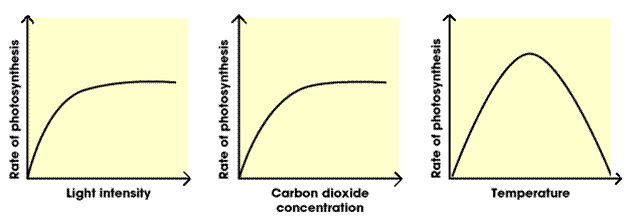Photosynthesis is a process by which plants prepare their own food in the presence of water, chlorophyll, sunlight, and CO2. This process occurs mainly in the leaves of the plants. In some other plants, the stems also perform photosynthesis. Photosynthesis occurs in the chloroplast cells of the leaves. There are several factors affecting photosynthesis- its rate and efficiency. Let’s look at these factors affecting photosynthesis and understand how they affect.
Suggested Videos
Factor Affecting Photosynthesis
Light
It is one of the major factors affecting photosynthesis. Photosynthesis cannot occur in the dark and the source of light for the plants is sunlight. Three attributes of light are important for photosynthesis:
- Intensity: Photosynthesis begins at low intensities of light and increases till it is maximum at the brightest time of the day. The amount of light required varies for different plants. Photosynthesis uses maximum up to 1.5 % light in the process and so light is generally not a limiting factor at high intensity. However, the light becomes a limiting factor in low intensity because no matter how much water or CO2 is present, without light photosynthesis cannot occur. At high intensities, the temperature of the plant increases which leads to increased transpiration in the plant. This leads to the closing of the stomata which leads to a reduced CO2 intake. Thus, leading to a reduction and finally stoppage of photosynthesis. Therefore, excessive light inhibits photosynthesis.
- Quality: Experiments conducted by Engelmann prove that the chlorophyll most effectively absorbs red and blue wavelengths from the entire spectrum of light. Thus, maximum photosynthesis occurs when the plant is exposed to the light of these wavelengths.
- Duration: The longer the plant is exposed to light, the longer the process of photosynthesis will continue. As long as the temperature of the plant remains balanced, photosynthesis will occur.

(Image source: biology-igcse.weeble.com)
Learn more about Light Reaction of Photosynthesis in more detail here.
Carbon Dioxide Concentration
The atmosphere contains 0.03% of carbon dioxide amidst other gases. Plants take in carbon dioxide from the air. But, since the amount of CO2 in the air is very less, it acts as a limiting factor for photosynthesis. Experiments have been performed to study the rate of photosynthesis on increasing the concentration of CO2 in the atmosphere.
It is seen that, when light and temperature are not the limiting factors, increasing CO2 concentration leads to an increase in the rate of photosynthesis. But, beyond a certain limit, CO2 starts accumulating in the plant and this leads to slowing down of the process. So, excessive CO2 inhibits photosynthesis especially when it starts to accumulate.
Browse more Topics under Photosynthesis In Higher Plants
Temperature
It is commonly seen in all biological and biochemical processes that they occur best in a certain optimum range of temperature. This holds true for photosynthesis as well. It is observed that, when CO2 and light are not limiting factors, the rate of photosynthesis increases with increase in temperatures till the optimum level for that plant. Beyond the optimum levels on both sides of the normal range, the enzymes are deactivated or destroyed and photosynthesis stops.
Water
Water is considered one of the most important factors affecting photosynthesis. When there is a reduced water intake or availability, the stomata begin to close to avoid loss of any water during transpiration. With the stomata closing down the CO2 intake also stops which affects photosynthesis. Therefore, the effect of water on photosynthesis is more indirect than direct.
Oxygen
Optimum levels of oxygen are favourable for photosynthesis. Oxygen is needed for photorespiration in C3 plants and the by-product of photorespiration is CO2 which is essential for photosynthesis. Also, the energy generated during the oxygen respiration is needed for the process of photosynthesis as well. However, an increase in the oxygen levels beyond the optimum for the plant leads to inhibition of photosynthesis.

(Image Source: indiana.edu)
This is because oxygen tends to break down the intermediaries that are formed in photosynthesis. Oxygen also completes with CO2 to combine with RUBISCO which a part of the dark reaction of photosynthesis and photorespiration. Therefore, increased levels of O2 would mean that RUBISCO will combine with O2 to initiate photorespiration and photosynthesis will slow down.
Learn more about Dark Reaction and Photorespiration in more detail here.
Blackman’s Principle of Limiting Factors
This principle states that when a process is governed by more than one factor, the rate of the process is governed by that factor which is closest to its minimum value.

(Image source: harennotes4u.blogspot.com)
For example, if a leaf is exposed to a certain amount of light intensity with constant temperature but the CO2 available is less, the rate of photosynthesis will not increase with an increase in the light intensity. Therefore, in this case, CO2 is the limiting factor.
Question For You
Q: Which of these factors do not affect photosynthesis?
(a) Water (b) Stomata
(c) CO2 (d) Temperature
Sol. (b) The number of stomata. Photosynthesis is affected by light, temperature, water, and CO2. Stomata affect the process of transpiration and do not affect photosynthesis.







How to remember the dark reaction in biology